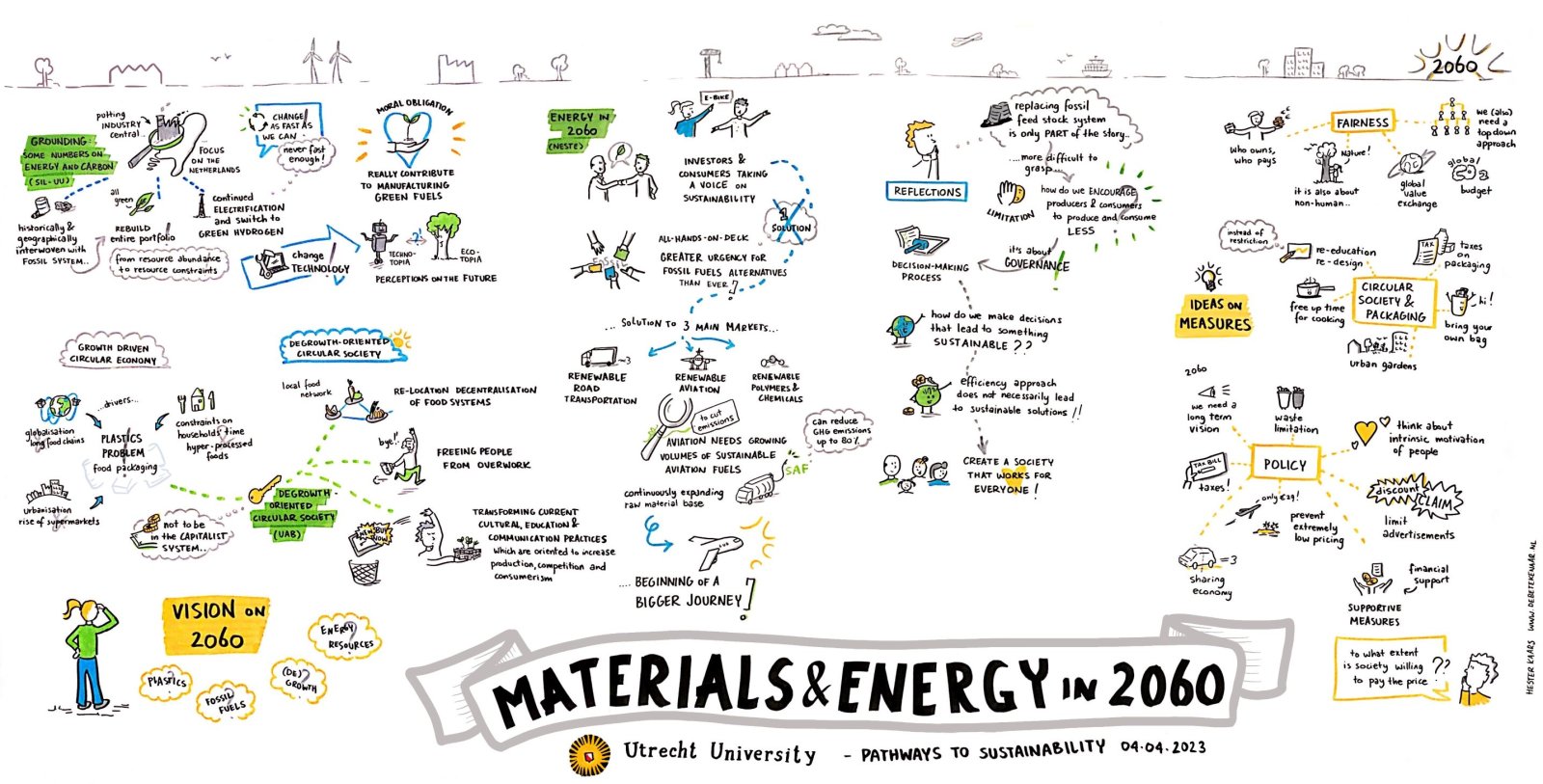Recap Materials and Energy in 2060
Pathways Conference 'See the Future'

At the Pathways to Sustainability Conference, the Materials & Energy in 2060 breakout session brought together 80 participants to explore various perspectives on material and energy use in the future. Five speakers discussed material and energy challenges, including global resource challenges, sustainable energy and materials, and the need for radical and sustainable transformations in society. The visual report of the session, created by Hester Kaars, is shown above.
The Materials & Energy in 2060 breakout session of the Pathways to Sustainability Conference brought together around 80 participants to engage and explore multiple perspectives on material and energy use in the future. The session featured five speakers who provided different perspectives on the topic, including an overview of material and energy challenges, the need for a degrowth-oriented circular society approach, the journey of a company towards sustainable energy and materials, global resource challenges, and the role of governance in enabling radical and sustainable transformations in society.
Gert Jan Kramer presented an overview of the material and energy challenges and introduced two future worldviews (‘technotopian’ and ‘ecotopian’, see also on the subjoined drawing by Hester Kaars). Martin Calisto Friant discussed the need for a degrowth-oriented circular society approach to change production and consumption patterns. Susanne Bouma shared the journey of the company Neste towards sustainable energy and materials. Mark Intven discussed the global resource challenges and the role of the European chemical industry and Rob Buurman emphasized the crucial role of governance in enabling radical and sustainable transformations in society.
Together, the speakers provided a multifaceted view of the material and energy challenges that our society faces, and the strategies needed to address them. Read the full summary of the session below or have a look at the slides of the speakers and the discussion questions which can be downloaded from this page.
Gert Jan Kramer presented an overview of the material and energy challenges by providing facts and figures on current energy and carbon use in the Netherlands and an aspired use in a future sustainable and circular economy. He addressed the assumptions on this future scenario, like domestic production of material demands (preventing systematic displacement of production and emissions to other parts of the world), electrification of all sectors that do not rely on hydrocarbons (e.g. housing, local and regional transport) and large-scale offshore wind production (100 GW corresponding with approx. 25% area of Dutch North Sea). With available technologies, continued electrification, switching to green hydrogen, and the conversion of 20 MtC biomass and waste (of which 3 MtC domestic) in circular materials and fuels, he shows a plausible scenario for sustainable materials and energy use in 2060.
Martin Calisto Friant stressed that technology is important but insufficient for sustainable materials and energy use in 2060. He highlighted the need for a degrowth-oriented circular society approach, based upon the example of food packaging. He explains the needed transformations by addressing the current drivers for food packaging use (e.g. long food chains, household time, processed foods) and what is needed to change this problematic use; examples include the transformations to green and healthy diets, re-localisation and decentralisation of food systems, consumption patterns based on sufficiency and solving household time constraints. He provides practical guidance on cultural, education and communication practices to enable transformations to slower, healthier and more convivial ways of life with sustainable material and energy use in 2060.
Susanne Bouma from Neste talked about the journey towards sustainable energy and materials in 2060 from a company perspective. Neste started as a regional oil refiner in Finland and aims to become a global leader in renewable and circular solutions for three markets (road transport, aviation, polymers and chemicals). Neste’s renewable products currently make up 94% of Neste’s profits.Neste aims to process more than 1 Mt of waste plastics annually from 2030 onwards and for carbon neutral production by 2035. She focuses on material and energy needs for aviation and sketches how a combination of technology, operations and infrastructure measures, sustainable aviation fuels and of offsets can transition towards net zero. To replace fossil fuel based aviation fuel, a continuous expansion of alternative raw materials is needed, from used cooking oil and animal fats to waste materials (lignocellulose, municipal solid waste) to potential algae and synthetic fuels from 2030 onwards. These fuels are expected to remain more expensive than current fossil jet fuels.
Mark Intven from VNCI, discussed the challenge of material and energy use in 2060 from a global perspective, including population growth and human development versus the global ecological capacity of the planet. The trends result in significant global resource challenges and show the need to extract and recycle resources to keep them in the loop and even better, design products that will never go to waste. Mark explains in more detail the European policies to a circular and net zero economy and the role of the European chemical industry in achieving these goals.
Rob Buurman, director of the Recycling Netwerk Benelux (RNB), emphasized the crucial role that governance plays in enabling radical and sustainable transformations in society. He shared his vision that a sustainable circular economy cannot be achieved without a fundamental shift in the way we govern our societies. For plastics, this means a.o. policies and regulation to prevent all redundant packaging (e.g on greengrocery and fruit), re-use of packaging and deposit schemes to enable the use of material resources within planetary boundaries.
After the presentations, all participants gathered in small groups to discuss issues related to material and energy use in the future.

